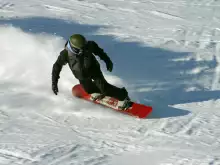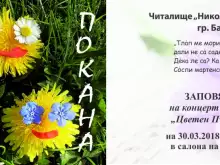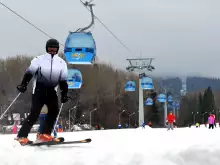Bansko - The Best of Bulgaria and Eastern Europe

Riding the gleaming blue Doppelmayr gondola up the Pirin mountains over a pine forest blanketed by overnight snow, it was easy to imagine we were in the French Tarentaise rather than Bulgaria. The meticulously groomed pistes and a final glorious descent in a bowl at the top of the ski area, through 15cms of light powder, did nothing to dispel the illusion. It was the lunch bill that restored reality. A welcoming hut with honest mountain fare before a roaring log fire are essential components of the perfect skiing day. But in recent years the cost of a long lunch in the French or Swiss Alps has reached iniquitous heights.
Even a modest meal at a waiter - service restaurant in Val d’Is? re is ? 20 a head without drinks. In high - flying Courchevel the damage can easily be double.
Here it was a different story. ? 10 for two, with a decent bottle of local Cabernet Sauvignon? Surely some mistake. Back in M? ribel it barely buys a soggy sandwich. A six - day lift pass costs ? 100 compared with ? 150 in the Trois Vall? es. In town, a beer is 50 - 70p, chicken and chips ? 2. Last season the combination of rock - bottom prices and a high standard of mountain facilities made Bansko the hottest property in European skiing - and the trend seems set to continue. Bansko lies close to the Macedonian and Greek frontiers and on a clear day you can see the Aegean Sea.
Russians, Greeks and a prodigiously high number of British skiers and snowboarders flocked to the new resort a two - and - a - half hour drive south of Sofia. Many of them returned home with more than just memories, having bought their own ski homes at a tenth of prices in the French Alps. They have already made - on paper - a 10 per cent profit. You could still buy a studio at the base of the ski area for ? 40, 000 while ? 80, 000 secures a luxurious two - bedroom apartment.
For ? 15, 000 you become the proud owner of a tumbledown stone - and - wood farmhouse in a nearby village such as Dobrinishte, although it would probably cost you at least twice that to do it up. In the days of the Ottoman Empire, Bansko was an important staging post on the caravan route from Constantinople to Thessaloniki.
More recently the ancient town, a quaint huddle of old stone buildings and cobbled streets with gaping storm drains, was better known for its school of Orthodox icon painting than for its pistes. All that changed five years ago when a Sofia - based property company finally took the step from which foreign investors had previously shied. Ulen spent ? 95million on making Bansko a modern ski resort, first building a state - of - the - art gondola, seven chairs, and three drags. A second gondola and more lifts are in the pipeline. (The present piste map is more a creative view of future development than currently available mountain transport. )
Ulen’s involvement was sufficient to encourage others to build an Ian Woosnam designed golf course. A local businessman funded construction of the five - star Grand Arena Hotel to which the German Kempinski group lent its name and management. Historic Bansko was temporarily transformed into boomtown Bulgaria and what was dubbed the capital of the Wild East became a giant construction site dotted with such a forest of concrete and cranes that the town’s status as a UNESCO World Heritage Site was jeopardised. Stricter planning procedures have now been introduced.
For the present, Bansko offers by far the best skiing in Eastern Europe - though, admittedly, local competition is slim in a region were hardly any new lifts have been built in the 15 years since the fall of Communism. But what foreign investors get for their money in Bansko is a season ticket to the only former Eastern Bloc resort that genuinely has the potential to become a bold - type name on the ski map of Europe.
Better - known Borovets now has similar development plans and other Eastern resorts will no doubt follow. However, unlike its rivals, Bansko has the overwhelming advantage of untapped challenging terrain for the development of a new Verbier or St Anton. At present the ski area has a vertical drop of 1100m - 1, 600m if you include the gentle push back to town. Its 65km of piste is expected to triple over the next five years. The old town below the purpose - built ski village surprisingly lacks any of the brutalist architecture of the Communist era, providing an alternative base with considerable charm.
The utilitarian cafes and Dickensian shops that served the simple needs of the townsfolk before tourism are gradually being replaced by fashion boutiques, wine bars and pizzerias, but the Mehanas - traditional Bansko taverns which often have live music - have risen to the challenge of catering for the new breed of visitor. Competition is keen and “greeters” in Bulgarian national costume loiter outside the larger ones, beckoning tourists to enter.
Once you are inside, the ambience is invariably warm with a hearty blaze in an open fireplace - although the hearty meals of barbecued lamb and assorted offal can fall short of western standards. With alcohol available at low prices, Bansko has quickly found its feet with a reputation as a party town. The Happy End and The Lions Pub are the resort’s best shots at international apr? s - ski, while the Torino cabaret bar attracts smart weekenders from Sofia. Amnesia and No Name are the most popular late - night clubs.
Catch Bansko while prices are still lower than in any other resort of comparable quality in Europe. The Pyrennean principality of Andorra is perhaps its only rival, but the prices there have risen dramatically since joined the euro zone.
News
- New
- Last commented
 Bansko gathers the best snowboarders in the world
Bansko gathers the best snowboarders in the world Bansko Puts up its Easter Decorations
Bansko Puts up its Easter Decorations Bansko Opens the New Winter Season on December 16
Bansko Opens the New Winter Season on December 16 The Starchevata Festival to be Held for 7th Year in a Row
The Starchevata Festival to be Held for 7th Year in a Row Folklore Festival to Gather Fans at Eleshnitsa
Folklore Festival to Gather Fans at Eleshnitsa Tourist Boom in the Bear Park Near Belitsa
Tourist Boom in the Bear Park Near Belitsa Summer Theater Begins in Bansko
Summer Theater Begins in Bansko




